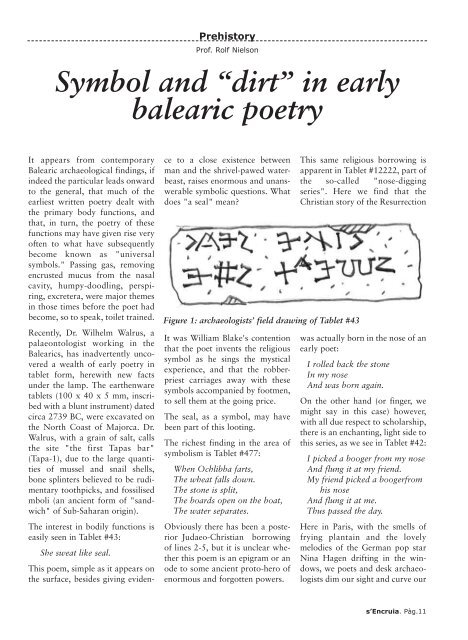s'encruia79 - Ferran Sintes
s'encruia79 - Ferran Sintes
s'encruia79 - Ferran Sintes
You also want an ePaper? Increase the reach of your titles
YUMPU automatically turns print PDFs into web optimized ePapers that Google loves.
It appears from contemporary<br />
Balearic archaeological findings, if<br />
indeed the particular leads onward<br />
to the general, that much of the<br />
earliest written poetry dealt with<br />
the primary body functions, and<br />
that, in turn, the poetry of these<br />
functions may have given rise very<br />
often to what have subsequently<br />
become known as "universal<br />
symbols." Passing gas, removing<br />
encrusted mucus from the nasal<br />
cavity, humpy-doodling, perspiring,<br />
excretera, were major themes<br />
in those times before the poet had<br />
become, so to speak, toilet trained.<br />
Recently, Dr. Wilhelm Walrus, a<br />
palaeontologist working in the<br />
Balearics, has inadvertently uncovered<br />
a wealth of early poetry in<br />
tablet form, herewith new facts<br />
under the lamp. The earthenware<br />
tablets (100 x 40 x 5 mm, inscribed<br />
with a blunt instrument) dated<br />
circa 2739 BC, were excavated on<br />
the North Coast of Majorca. Dr.<br />
Walrus, with a grain of salt, calls<br />
the site "the first Tapas bar"<br />
(Tapa-1), due to the large quantities<br />
of mussel and snail shells,<br />
bone splinters believed to be rudimentary<br />
toothpicks, and fossilised<br />
mboli (an ancient form of "sandwich"<br />
of Sub-Saharan origin).<br />
The interest in bodily functions is<br />
easily seen in Tablet #43:<br />
She sweat like seal.<br />
This poem, simple as it appears on<br />
the surface, besides giving eviden-<br />
Prehistory<br />
Prof. Rolf Nielson<br />
Symbol and “dirt” in early<br />
balearic poetry<br />
ce to a close existence between<br />
man and the shrivel-pawed waterbeast,<br />
raises enormous and unanswerable<br />
symbolic questions. What<br />
does "a seal" mean?<br />
Figure 1: archaeologists’ field drawing of Tablet #43<br />
It was William Blake's contention<br />
that the poet invents the religious<br />
symbol as he sings the mystical<br />
experience, and that the robberpriest<br />
carriages away with these<br />
symbols accompanied by footmen,<br />
to sell them at the going price.<br />
The seal, as a symbol, may have<br />
been part of this looting.<br />
The richest finding in the area of<br />
symbolism is Tablet #477:<br />
When Ochlibba farts,<br />
The wheat falls down.<br />
The stone is split,<br />
The boards open on the boat,<br />
The water separates.<br />
Obviously there has been a posterior<br />
Judaeo-Christian borrowing<br />
of lines 2-5, but it is unclear whether<br />
this poem is an epigram or an<br />
ode to some ancient proto-hero of<br />
enormous and forgotten powers.<br />
This same religious borrowing is<br />
apparent in Tablet #12222, part of<br />
the so-called "nose-digging<br />
series". Here we find that the<br />
Christian story of the Resurrection<br />
was actually born in the nose of an<br />
early poet:<br />
I rolled back the stone<br />
In my nose<br />
And was born again.<br />
On the other hand (or finger, we<br />
might say in this case) however,<br />
with all due respect to scholarship,<br />
there is an enchanting, light side to<br />
this series, as we see in Tablet #42:<br />
I picked a booger from my nose<br />
And flung it at my friend.<br />
My friend picked a boogerfrom<br />
his nose<br />
And flung it at me.<br />
Thus passed the day.<br />
Here in Paris, with the smells of<br />
frying plantain and the lovely<br />
melodies of the German pop star<br />
Nina Hagen drifting in the windows,<br />
we poets and desk archaeologists<br />
dim our sight and curve our<br />
s’Encruia. Pàg.11



